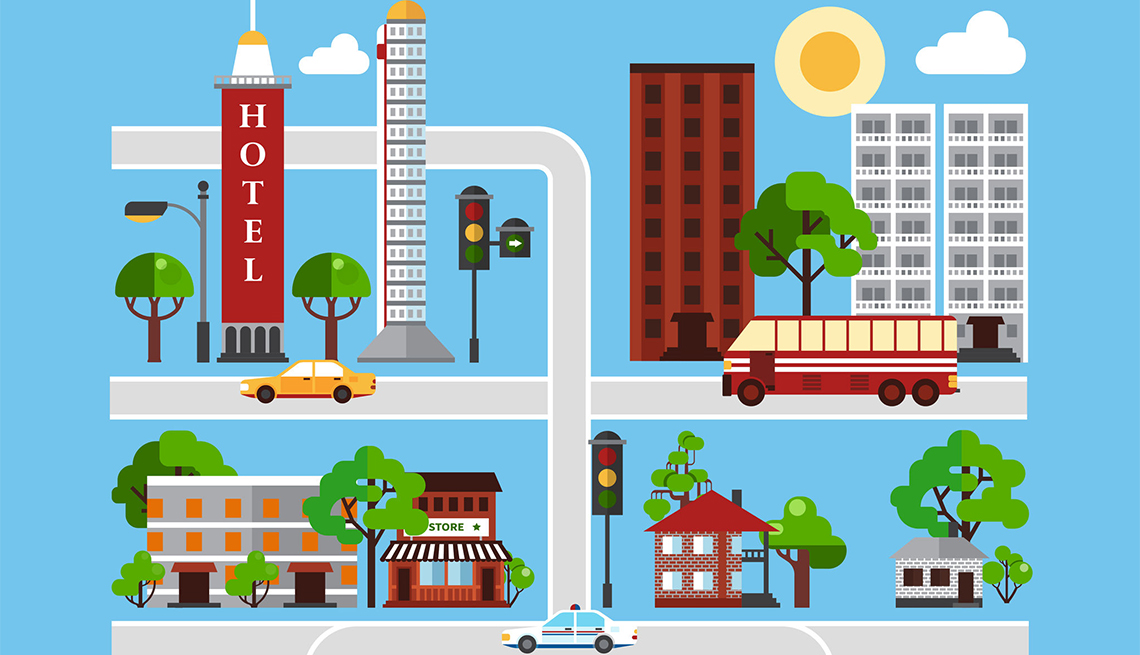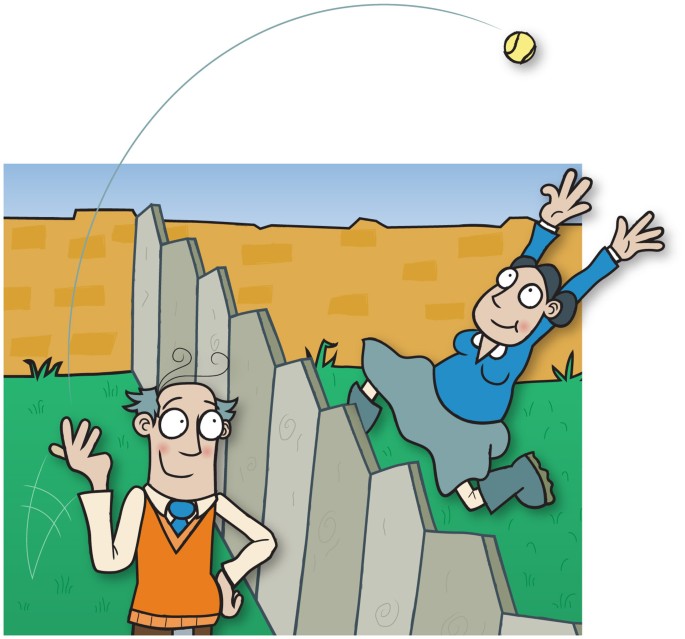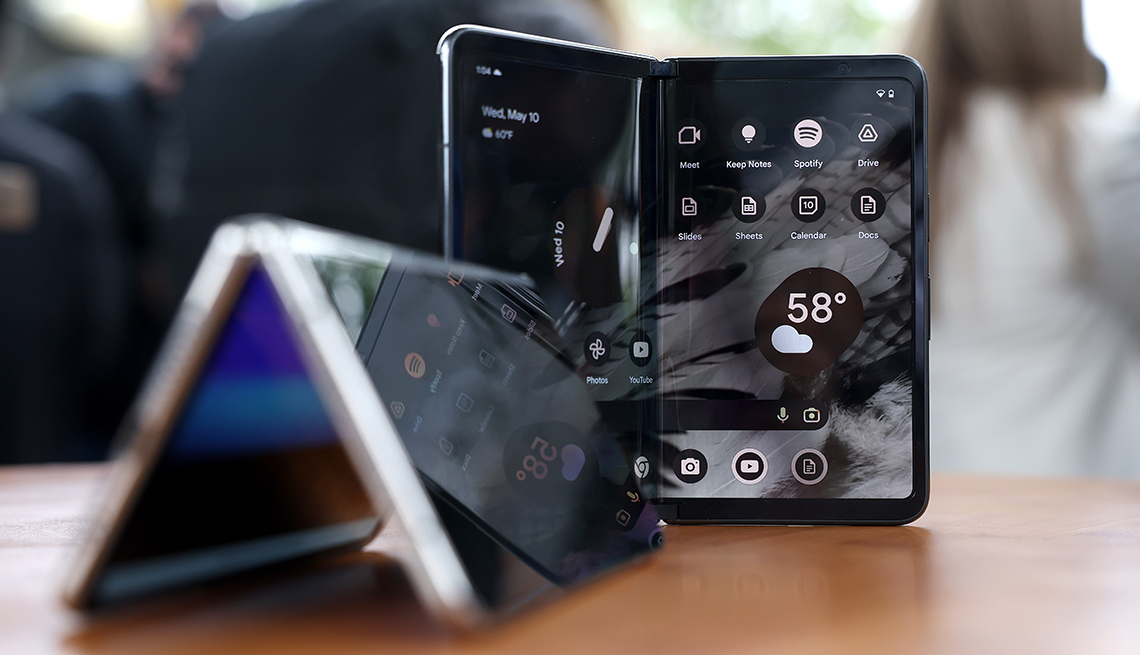
- Select a language for the TTS:
- UK English Female
- UK English Male
- US English Female
- US English Male
- Australian Female
- Australian Male
- Language selected: (auto detect) - EN
Play all audios:
The following sessions are listed in alphabetical order. PDFs of the presentations or handouts are available for some. To see the day's complete schedule, visit the main page for the
2017 AARP Livable Communities National Conference. 1. AGE- AND DEMENTIA-FRIENDLY TOGETHER ON THE MASSACHUSETTS COAST Age Friendly Massachusetts, the Massachusetts Healthy Aging
Collaborative, the Tufts Health Plan Foundation and Dementia Friendly Massachusetts are working with four municipalities in the Cape Ann region to incorporate dementia friendly
considerations at the start of their age-friendly process. Communities that want to implement both age-friendly and dementia-friendly initiatives will benefit from an understanding of how
the "Better Together" initiative was implemented. (PDF) * James Fuccione, Director, Massachusetts Healthy Aging Collaborative * Emily Kearns, Coordinator, Dementia Friendly
Massachusetts * Valerie Spain, Program Specialist, AARP Massachusetts 2. BUILDING A LIVABLE INDIANAPOLIS THROUGH TRANSIT Earlier this year, AARP Indiana worked closely with a diverse
coalition to pass a transit referendum that provides a dedicated source of funding for the Indianapolis transit system. Ellen Forthofer of IndyGo, the city's transit provider, will
share her thoughts and both speakers will discuss their involvement in the work and how the funding will improve the transit system in the city and Marion County. Mandla Moyo will discuss
best practices for involving, supporting and engaging elected leaders in local advocacy efforts. * Ellen Forthofer, Communications and Outreach Coordinator, IndyGo * Mandla Moyo, AARP
Indiana Director of Community Engagement 3. BUILDING A PUBLIC REALM THAT CREATES REAL VALUE With dwindling public resources, downtowns and business improvement districts are increasingly
turning to partners to provide a variety of services and capital investments. Public amenities are among the most important investments to make in cities. This session will discuss best
practices for working with project partners to plan, design, build and program public realm improvements. It will also address the why, what, how, and who of building great cities, one piece
at a time. * Craig Lewis, Principal, Stantec * Jeff Sauser, Associate, Stantec 4. BUILDING A TRAINED ADVOCACY CORPS: LESSONS FROM URBAN SOCIAL MOVEMENTS Social change in our cities has
seldom occurred without the influence of movement activists. Successful urban social movements and similar frameworks from the past should guide our efforts to develop a trained advocacy
corps focused on a broad range of livability issues with the goal of creating communities and neighborhoods that work for all ages and abilities. In this presentation, aging studies
professor Sharon Baggett discusses the results of a three-year training grant in which citizen advocates, older adults and people with disabilities participated in an intensive five-day
training to gain knowledge and develop "livability advocacy" skills for achieving needed community change. (PDF) * Sharon Baggett, Ph.D., Associate Professor of Aging Studies,
Center for Aging and Community, University of Indianapolis 5. COMPLETE STREETS AND VISION ZERO: COMPLEMENTARY APPROACHES TO MAKING OUR ROADWAYS SAFE For many years, AARP state offices have
been advocating for states and localities to adopt Complete Streets laws, ordinances and policies to ensure that roadways enable safe access for all user. The goal of Vision Zero is to
eliminate all traffic fatalities and severe injuries and, at the same time, enable safe, healthy and equitable mobility for all. Session attendees will hear from leaders of the Complete
Streets and Vision Zero movements and learn how advocates can use both concepts to further the goal of making streets safer for all. * Emiko Atherton, Director, National Complete Streets
Coalition * Kathleen Ferrier, Policy and Communications Director, Vision Zero Network * Adam Goldberg, Senior Advisor, AARP 6. COMPLETE STREETS IMPLEMENTATION: ENGAGING INFLUENCERS AND
RESIDENTS Without an implementation and funding plan, passing a Complete Streets ordinance is only a partial win. Learn how one city motivated planners, leaders and residents to implement
Complete Streets in the areas of greatest need. Panelists will discuss their data driven pilot project that settled turf battles, unified thinking and drove change in vulnerable
neighborhoods. (PDF) * Troy Broussard, Associate State Director, AARP Louisiana * Rachel Diresto, Executive Vice President, Center for Planning Excellence * Jeanne George, Co-Lead, BR
Sustainable Transportation Action Coalition * Lynn Maloney-Mujica, Project Manager and Senior Scientist, ELOS Environmental 7. CREATING HEALTHY PLACES FOR HEALTHY PEOPLE: STORIES FROM THE
ROAD Many health care institutions, such as nonprofit hospitals and community health centers, recognize that health starts outside of a hospital walls. Community leaders in
economically-struggling areas are discovering that health care partners are economic anchors that can redefine and reinvigorate local economies. In this interactive session, participants
will learn about Nogales, Arizona, where a federally qualified health center is creating a downtown clinic to anchor revitalization efforts; Anderson, Indiana, where local hospitals, the
city and the metropolitan planning organization is creating and connecting health districts to serve as neighborhood centers; and Waterville, Maine, where two hospitals are partnering with
the city, colleges and public health and economic development partners to improve access to healthy food. __ * Susan Kunz, Chief of Program Development, Mariposa Community Health Center *
Michelle Madeley, Environmental Protection Specialist, USEPA * Jen Olsen, CEO, LocalFirst, and Member, Healthy Waterville Steering Committee * Ryan Phelps, Senior Transportation Planner,
Madison County Council of Government 8. EVALUATING AND APPROACHING LOCAL LIVABLE COMMUNITY ADVOCACY "Local advocacy" is sometimes synonymous with advocacy for more livable
communities. Yet with so many ways to enhance livability for individuals of all ages, it can sometimes be difficult to determine what advocacy initiatives stakeholders should engage in. This
session will offer participants a strategy for evaluating whether advocacy in a livable/local arena would be advantageous for the 50-plus and the community-at-large. Housing and
transportation will be discussed, along with questions to consider, case studies and new resources. (PDF) * Steve Carter, Senior Advisor, AARP Office of Community Engagement * Coralette
Hannon, Senior Legislative Representative, AARP Georgia * Mandla Moyo, Associate State Director of Advocacy and Outreach, AARP Indiana * Barrie Tabin Berger, Senior Legislative
Representative, AARP 9. FINANCING STRATEGIES FOR LIVABLE COMMUNITIES There is usually little disagreement that better roads, bridges, transit, housing and health access enhances community
livability for people of all ages. The trouble sometimes comes in reaching consensus among stakeholders regarding how to finance these kinds of improvements. This session will review and
evaluate new proposals to finance livable communities in both states and cities. Taxes, fees, bonds and other mechanisms will be discussed, as will best practices about building consensus
for a particular financing vehicle. (PDF) * Gerri Madrid-Davis, Director, AARP Financial Security and Consumer Affairs * Roberto Rey, Associate State Director of Multicultural Outreach, AARP
Colorado * Barrie Tabin Berger, Senior Legislative Representative, AARP * DeAnza Valencia, Associate State Director of Advocacy, AARP New Mexico 10. HOW TO TRANSFORM YOUR CITY TO BE
AGE-FRIENDLY WITHIN DAYS, NOT YEARS Building infrastructure for people that want to walk, bike, ride transit and use mobility devices is good for the planet, makes us healthier and develops
stronger communities. This session will cover the process of building a better block with an emphasis on new methods. Participants will receive an introduction to tactical urbanism, hear
about examples from AARP-led projects, walk away with a checklist of how to create a successful project and gain a firm understanding of how to get started on projects ranging from bike
lanes to complete roadway makeovers. * Andrew Howard, Principal, Team Better Block * Kelly Stoddard-Poor, Associate State Director of Outreach, AARP Vermont 11. HOW WE ROLL: BIKEABLE
COMMUNITY WORKSHOPS IN MINNESOTA Minnesota has been working to increase the bike-friendliness of its communities in order to support lifelong physical activity. Improving trail and on-street
bicycle facilities also helps support affordable transportation options that improve equity and create more livable, vibrant communities. A unique collaboration of state agencies including
the Minnesota Department of Health, Minnesota Department of Transportation and the Bicycle Alliance of Minnesota has been supporting communities to launch the process to be recognized as a
national "Bicycle Friendly Community." This session explains the collaborative process for conducting workshops, assisting communities through the process, sharing success stories
and implementing change. (PDF) * Kelly Corbin, Physical Activity Coordinator, Minnesota Department of Health * Natalie Gille, Program Manager, Bicycle Alliance of Minnesota * Michael
Petesch, Bicycle and Pedestrian Data Coordinator, Minnesota Department of Transportation 12. IT TAKES A VILLAGE: BUILDING COLLECTIVE STRATEGIES TO SUPPORT MULTI-SECTOR COLLABORATION The
places where people live, work, play and age are pivotal to advance health and equity across the lifespan. To develop and sustain successful community prevention initiatives, public health
practitioners, local leaders, government officials and others recognize that multi-sector partnerships and collaboration expand available resources, strategies and capabilities to achieve
outcomes that could not be accomplished by one field alone. This workshop will introduce participants to what it takes to develop and strengthen collective strategies among their coalitions
and networks. Participants will learn about the Prevention Institute's _Collaboration Multiplier_, an interactive tool for supporting collaborative efforts across diverse fields. *
Maureen Silva, Associate Program Manager, Prevention Institute 13. MEANINGFUL PARTICIPATION FOR UNDER-REPRESENTED OLDER ADULTS IN AGE-FRIENDLY COMMUNITIES This presentation will discuss
successful strategies from Western New York and the Age Friendly Erie County collaboration, which is led by a multi-sector partnership of government, university and human service
organizations. Participants will learn about (1) effective brainstorming and collaboration across a large network of age friendly community organizations, (2) outreach and the meaningful
engagement of underrepresented older adults in developing priorities, and (3) local foundation funding to adopt human-centered design practices in senior services. * Randy Hoak, Associate
State Director, AARP New York * Brittany Perez, OTD, OTRL, Co-Director Age Friendly Erie County/Senior Research Associate, University at Buffalo Center for Inclusive Design and Environmental
Access * Molly Ranahan, Ph.D., Co-Director, Age Friendly Erie County/Evaluator, Community Connections of New York 14. MEETING THE DEMAND FOR HOMES THAT MAKE LIFE EASIER What makes a home
livable for a lifetime? Rosemarie Rossetti, Ph.D., an internationally recognized expert in universal design and accessible housing, knows firsthand the choices and challenges involved. From
her own experience using a wheelchair Rossetti provides poignantly personal insights and proven strategies for creating age-friendly, livable housing that maximizes safety, independence,
convenience and peace of mind for every resident in every room of their home. (Website: udll.com) * Rosemarie Rossetti, Ph.D., President, Rossetti Enterprises, Inc_._ 15. MISSING MIDDLE
HOUSING: SUCCESSES IN ADVANCING THE LIVABLE COMMUNITIES DISCUSSION Missing Middle Housing types — duplexes, fourplexes, courtyard apartments, and more — have become an increasingly important
part of age-friendly, livability efforts nationwide. In this session, architect Daniel Parolek, the country's foremost expert on Missing Middle Housing, will explain and compare
examples of Missing Middle Housing and demonstrate how communities have effectively begun using the concept to build momentum for livable communities, addressing important issues such as
housing affordability, housing choice and neighborhood compatibility. Following Parolek's presentation, a panel of AARP state office leaders will share their experiences framing the
discussion around livable places and Missing Middle Housing in their own communities. (NOTE: In addition to this session, Daniel Parolek will be leading a walking tour field trip of a Dallas
neighborhood that features Missing Middle Housing.) * Daniel Parolek, Founding Principal, Opticos Design, Inc. * Rafi Nazarians, Associate State Director, AARP California * Bandana
Shrestha, Director of Community Engagement, AARP Oregon * Kent Sovern, State Director, AARP Iowa 16. SAFER COMMUNITIES IN AN AUTONOMOUS VEHICLE WORLD Society stands at the threshold of an
astonishing mobility revolution. Transportation sector innovations offer real solutions to reduce isolation for seniors, eliminate congestion on the nation's roads, move communities
toward more livable environments, and dramatically reduce injuries and deaths from automobile related crashes. This session walks through what the current autonomous vehicle landscape looks
like. Participants will hear from an automobile manufacturer about how connected vehicle technologies may interface with community infrastructure and learn how AARP is actively deploying
vehicle technology education to help mature drivers understand current and evolving vehicle safety technologies. * Ed Bradley, Program Manager, Toyota Motor North America, Inc. * Karen
Keene, Senior Strategic Advisor, AARP Enterprise Strategy and Innovation * Jodi Olshevski, Executive Director, Hartford Center for Mature Market Excellence * Kyle Rakow, Vice President and
National Director, AARP Driver Safety 17. STRENGTHENING CITIZEN ENGAGEMENT AT THE MUNICIPAL LEVEL Engaging citizens to participate in creating systems, developing policy, and planning and
implementing programs is essential to solving public problems. But engaging citizens in a coordinated, authentic, and results-driven manner is complex and often a rare occurrence. This
session will provide city leaders and community partners with an overview of municipal-led citizen engagement, the importance of involving citizens in public problem solving, and an
understanding of how to plan and sustain effective citizen engagement over time. Through scenario-based learning, brainstorming, and breakout work, participants will walk away with a set of
techniques and best practices needed to start designing their own citizen engagement strategy. * Nikola Pavelic, Program Manager for Engagement Design, Cities of Service 18. SUSTAINING
LIVABLE COMMUNITIES ACROSS CHANGING LOCAL ADMINISTRATIONS Age-friendly practitioners know all too well that without support from elected officials in local government, age-friendly efforts
can be stymied. Successful age-friendly efforts are dependent upon local government buy-in, at a minimum. This session will present three experiences with sustaining age-friendly work across
changing administrations. The panelist will discuss the challenges, actions taken and lessons learned from their struggles to sustain age-friendly commitments and progress in their cities.
The session will be moderated by a national and international age-friendly expert who has worked with livable and age-friendly communities across the United States and abroad. * Laura
Cantwell, Associate State Director of Advocacy and Outreach, AARP Florida * Stephanie Firestone, Senior Strategic Policy Advisor, AARP International * Gail Kohn, Coordinator, Age-Friendly DC
* David Oh, Council Member at Large, Philadelphia City Council 19. THE LIVABILITY INDEX 2.0: CREATING COMMUNITIES FOR PEOPLE OF ALL AGES The Livability Index is an online resource that
measures how well communities are meeting the needs of residents across the lifespan. Since launching in 2015, community stakeholders are using the tool to spark conversations about
affordable housing, accessible and safe transportation options and community health. Members in the AARP Network of Age-Friendly Communities have also used the Livability Index as an
assessment tool. In this session, participants will learn how communities are using the tool and hear about website enhancements and new features ( including a way to measure progress over
time) that will be added in 2018. * Shannon Guzman, Policy Research Senior Analyst, AARP Public Policy Institute * Rodney Harrell, Director of Livability and Thought Leadership, AARP Public
Policy Institute 20. THE ROLE OF STATEWIDE PARTNERSHIPS IN LIVABLE COMMUNITIES This workshop will discuss the integral role of statewide partnerships at the nonprofit and governmental level
in making communities more livable for all ages. Learn how AARP Florida is collaborating with the Florida chapter of the American Planning Association through several initiatives including a
Plan4Health grant project aimed at better connecting planning and public health. Hear how AARP Florida is working with the Florida Department of Elder Affairs to provide education and
resources to communities that are interested in becoming more age-friendly through the AARP Network of Age-Friendly Communities. * Catherine Anne Avery, Bureau Chief of Elder Rights, Florida
Department of Elder Affairs * Laura Cantwell, Associate State Director of Advocacy and Outreach, AARP Florida * Julia A. Magee, Executive Director, American Planning Association Florida 21.
TINY HOMES FOR SENIORS Tiny homes offer a new alternative for affordable housing. Will they work for seniors? When SquareOne Villages (SOV) in Eugene, Oregon, built their tiny home village
of 22 tiny homes, more than half of the residents chosen for this pilot project were over the age of 60. This workshop will describe the benefits and challenges of building tiny homes as
affordable housing and what SOV learned in the process. The cost of the project, including common facilities, is less than half of the cost of traditional affordable housing projects. As a
result, a person living on just disability income or a senior with minimal Social Security income can make their monthly payment without dependence on public subsidies or vouchers. An online
toolbox developed by SOV provides concrete steps and guidance for others wishing to replicate its tiny home village model. * Dan Bryant, Executive Director, SquareOne Villages * Alicia
Ginsberg, Project Coordinator SquareOne Villages 2017 AARP LIVABLE COMMUNITIES NATIONAL CONFERENCE TO RETURN TO THE MAIN CONFERENCE PAGE: AARP.org/Livable2017 OUR PRIOR CONFERENCES: 2016 |
2015 | 2014 | 2013 More from AARP.org/Livable Use the dropdown to choose a livability topic. Select a Subject

:max_bytes(150000):strip_icc():focal(979x519:981x521)/naomi-judd-2000-04c023a3f5ad4201a6f1cbcbac4817b9.jpg)





